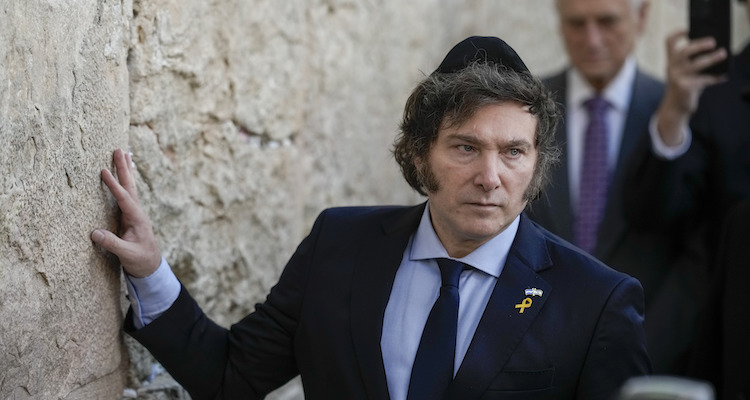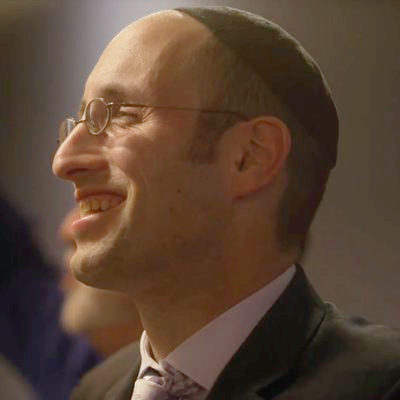Do Cry for Me, Argentina
How the president of Argentina captured, in a single moment, what the Western Wall is all about.

THOUSANDS OF YEARS ago, as Solomon dedicated the Temple in Jerusalem, he emphasized that the sanctity of the site was not for Israelites alone. There will be Gentiles, he predicted, who will be drawn to Jerusalem as a place of prayer, to direct their beseechings toward the Temple Mount:
Moreover concerning a Gentile, that is not of thy people Israel, but cometh out of a far country for thy name’s sake; For they shall hear of thy great name, and of thy strong hand, and of thy stretched-out arm; when he shall come and pray toward this house; Hear thou in heaven thy dwelling place, and do according to all that the Gentile calleth to thee for.
This prediction was fulfilled in February 2024. When the newly elected president of Argentina, Javier Milei,
alighted from his plane in Tel Aviv, he immediately announced he would be moving Argentina’s embassy
to Jerusalem. This was not a surprise; Milei’s affection for Israel, and for Judaism, has long been a part of his
public persona. He has undertaken study of Torah, has contemplated conversion, and plans to appoint his
personal rabbi as ambassador to Israel. An admirer of the late Lubavitcher Rebbe, and a visitor to his grave,
Milei has been seen in Jewish settings so often that one Hasidic comedian quipped that upon greeting Israel’s
foreign minister at the airport, he had to remove his yarmulke, or “kippa,” in order “to fit in.”
But the yarmulke was to come. From the airport, Milei proceeded to the Western Wall, as a crowd gathered around the visiting head of state. One report in Israeli media described the hubbub that emerged around him, with some supporting his libertarian policies and his scorn for socialist statism:
“He’s over there,” someone shouted. “In the black kippa!”
“They’re all in black kippas, bro,” the person next to him snapped back.…Most of the people at the Kotel, it seemed, had never heard of Milei before and were unaware of his political deeds. The increasingly boisterous crowd, which peaked at about 100, was attracted by the commotion, and maybe even the chance to get a selfie with or handshake from a world leader.
But there were others who had been waiting for him.
“He’s going to save Argentina, and he is a light for the free world,” said Yuval, who showed up early clutching a large Argentine flag. Yuval, who is half-Argentine, said he admired the new president’s economic outlook—”free markets, liberty”—and was wearing a shirt reading “technología capitalismo,” which he explained as “a philosophy in which technology and free markets can lower prices across the board.”
The importance of Milei’s visit was not about his economic policies, as significant as they are. The newspaper in which this account appeared, Haaretz, did not quite grasp the meaning of the moment, describing Milei’s approach to the Wall as having “bar mitzvah vibes.” That gets it exactly wrong. As Milei touched the millennia-old stones, he had none of the mien of a 13-year-old boy. He broke down and wept. The Western Wall had, for a moment, become the Wailing Wall again.
Milei’s reaction was all the more remarkable because it contrasted with his usual demeanor. With bushy hair, a propensity for posing with a thumbs-up posture, and long sideburns, he often appears, in Jonathan Schanzer’s felicitous phrase, as “the Argentinian Elvis.” But at the Wall, all coolness had vanished; the photo of the president’s tear-strewn face was a very different look, and one all the more memorable.
In the moment, Milei captured, deliberately or providentially, what the Western Wall is all about. The media described the site of Milei’s visit as “the holiest place where Jews can pray.” This is, in a certain sense true, reminding us of the fact that unfettered prayer is, unjustly, still banned on the Temple Mount, Judaism’s holiest site. But the truth is that in Jewish law, the Western Wall is no holier than any other site in Jerusalem; in the period when the Temple stood, it was a retaining wall. The notion that the site would serve as a sacred place of prayer would have seemed surpassingly strange.
What sanctified the Wall was Jewish tears after the Temple’s destruction. Under the Ottomans, who governed the area for centuries, the Wall was the closest site to the Temple Mount where Jews were allowed to pray. And mourn for what they had lost. One hundred and fifty years ago, in another fulfillment of Solomon’s prediction, a former American Secretary of State, William Seward, visited the city and gazed with awe at the Jews at the Wall: They were “reading and reciting the poetic language of the prophet, beating their hands against the wall, and bathing the stones with their kisses and tears,” we are told in a memoir edited by Seward’s son. “It is no mere formal ceremony. During the several hours while we were spectators of it, there was not one act of irreverence or indifference.”
This is the source of the sanctity of these stones. In standing at the Wall, Milei seemed to sense Jewish history itself, realizing that the pain of the current moment merged with the weeping that had gone before. He then gave voice to this insight in reflecting how Israel’s greatness can be understood only through the prism of the past. Visiting Yad Vashem, Milei emphasized the importance of fighting “modern Nazism today disguised as the terror group Hamas.” He then wrote in the visitor’s book:
In this symbolic and transcendent place, where darkness reaches unimaginable extremes of cruelty, it is precisely here that we can see the greatness of a people. The greatness of going through the pain and rising up again even stronger than before. We all bear the duty not to remain silent. Never again is now.
Incredibly, Milei was unconsciously echoing the sentiments of some of the first soldiers who had stood at the Wall. The Old City was liberated in 1967 by the 55th Paratroopers Brigade. Its deputy commander, Moshe Stempel, one of the first at the Wall, was by all accounts a tough soldier who nevertheless broke down and wept. A soldier who served under him, Yoram Zamosh, remembered the moment:
Twice he tried to speak and twice his voice failed. He pulled me so close that the brows of our helmets were touching. “Zamosh!” Stempel said, with such emotion that I can hear the words still, though he spoke them almost fifty years ago. “Zamosh, if my grandfather, if my great-grandfather, if any of my family who have been murdered in pogroms and in the death camps… if they could know, somehow, even for one second, that I, their grandson, would be standing here at this hour, in this place, wearing the red boots of an Israeli paratrooper …
Stempel went on to reflect how this knowledge would have offered succor and strength during his ancestors’ moments of trial. He then, according to Zamosh, connected the past and present to the future:
Stempel gripped my arm as if he would never let go. “We shall never, never leave this place,” he said. “Never will we give this up. Never.”
It is just this that some enemies of Israel truly fail to comprehend. But one non-Jewish leader, visiting Israel during a time of sorrow, reflected a profound understanding of the meaning of the sacred site. If Milei succeeds in his battle against socialism in South America, he will become an economic and political leader of Thatcherite proportions. But he has already earned a place in the memory of an eternal people when he touched stones hallowed by tears, allowed the weeping of past and present to merge. We, in turn, join Solomon in asking the Almighty to hear the prayer of the Gentile from afar, who in this moment of trial gave the Jewish people a brief moment of inspiration and joy.
This essay was originally published in Commentary.
How the president of Argentina captured, in a single moment, what the Western Wall is all about.
How the president of Argentina captured, in a single moment, what the Western Wall is all about.

